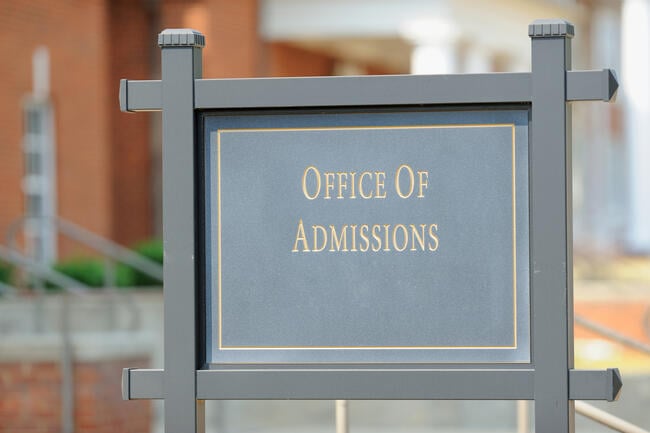You have /5 articles left.
Sign up for a free account or log in.

sshepard/iStock/Getty Images Plus
The attorney general’s July 29 memorandum on “Guidance for Recipients of Federal Funding Regarding Unlawful Discrimination” suggests that all those receiving federal financial assistance should review the offered guidance to ensure that they are complying with their “legal obligations”—despite stating in the previous paragraph that the enumerated “best practices” are not mandatory requirements (i.e., legal obligations) but instead “non-binding suggestions to help entities comply with federal antidiscrimination laws and avoid legal pitfalls.”
It seems clear that these are recommendations to encourage overcompliance with the law to avoid extralegal costs that the administration can impose on institutions as it so chooses.
Several of the suggested nonbinding “best practices” raise some interesting issues relating to college admissions. The administration seems particularly concerned about institutions using “unlawful proxies” for race such as “geographic or institutional targeting” to get around affirmative action policies, which the Supreme Court has declared illegal.
Since Black and Hispanic families in America are disproportionately poor, recruiting lower-income students, for example by recruiting in lower-income communities or from Title I high schools, will result in recruiting disproportionately more Black and Hispanic students. The guidance suggests that doing so will “violate federal law if designed or applied with the intention of advantaging or disadvantaging individuals based on protected characteristics” (such as race or gender).
This guidance, combined with President Trump’s Aug. 7 memorandum to the secretary of education requiring colleges and universities to submit additional data relating to admissions, suggests that the administration will be scrutinizing colleges’ admissions data for evidence of “unlawful proxy discrimination.”
But determining how, exactly, an admissions or recruiting policy is “designed or applied with the intention” of accomplishing a particular end is not straightforward, absent some statement of intent on the part of the institution. The outcome in terms of admissions data cannot be the proof, as the president’s memorandum suggests.
The administration seems highly concerned with colleges using indicators of low-income status as proxies to identify applicants who are Black and Hispanic. (Americans at large should of course be concerned that low-income status is indeed a good proxy for being Black or Hispanic.) But determining intention will prove difficult.
Here are several examples: Recruiting rural students has become a goal of many institutions. Rural communities are disproportionately (76 percent) white. Is the intent to recruit rural students or is it to recruit white students? If the intent is the latter, it would violate the attorney general’s guidance since it would advantage white students and disadvantage students of color. Recruiting students from private high schools raises similar issues, since 65 percent of private high school students are white, compared to 44 percent of students at public high schools.
Consider also athletic recruiting. Basketball and football recruits are disproportionately Black. Some might argue that the intent is to recruit good athletes, but could it also be a means of diversifying the student body? How does an institution or the administration prove intent? Athletic recruits are also predominately male, despite attempts under Title IX to remedy gender equity issues in athletics. Just focusing on football, it is clearly a means of recruiting men, and some colleges have invested in football, even creating a football program when they didn’t have one, for precisely this reason. The administration could, if being consistent, interpret these actions as being “unlawful proxy discrimination.”
Legacy admissions policies have been under attack for many years, and critics of the practice can now claim the attorney general’s memorandum supports ending the practice, which seems to disproportionately benefit white students. I’ve been dismissive of calls to end legacy admissions, because it seemed like critics were reaching the wrong conclusions about what would happen if the practice were eliminated. Critics argue that ending the practice would increase slots for low-income students. But absent a commitment to invest in more need-based aid, it is more likely that legacies would just be replaced by other high-income white students whose parents went to some other institution.
Legacy admissions policies were notably left unmentioned in the administration’s Aug. 14 proposal outlining the new admissions data colleges will be required to provide. How will the attorney general determine the intent of legacy admissions? Will the fact that it privileges white students, in the same way that recruiting from poor urban or Title I high schools privileges Black and Hispanic students, be adequate evidence of intent?
It seems likely that the administration really only cares about “unlawful proxy discrimination” if it benefits Black and Hispanic students. This is misguided for several reasons. First, the United States is falling behind on postsecondary educational attainment compared to other countries. In 2000, the United States ranked third, and now we are eighth. To increase overall higher education attainment in America, we need to increase attainment rates for those groups for whom it is low, and that includes Black and Hispanic students, as well as lower-income students. Also, societies thrive if all members feel that the rules of the game are fair and everyone has opportunity to advance.
All Americans should care about both of these issues.



